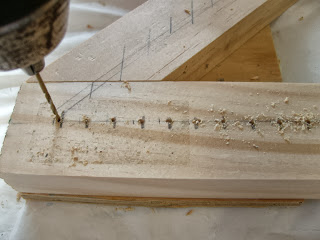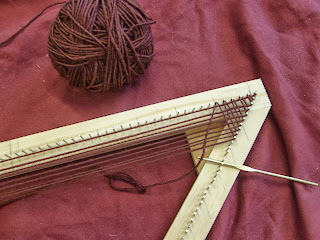This wasn't going to be my next topic, but since we have been shearing several days over the past couple weeks, it is timely.
I belong to several Facebook groups that have a varied interest base with a common factor of sheep and/or wool and associated practices. After following for several months, I have become aware that a good many of the fellow members are new to the wooly scene, or at least limited in their experience of the beginning stages of the process of many of the steps in moving the wool from the sheep to the finished product.
So I decided to put together a blog on one of the segments of the process. Please keep in mind that we here at Ewe And Us have been doing this for many years, made many adjustments along the way, and still seem to be making small changes every year. (This year being no exception, explanation will follow) While we follow the guidelines of the ASI wool handling guidelines, because we are a small specialty business, we most likely do things the way we do for a very practical reason - it works for us. In no way would we imply it is the proper or only way. In fact, if someone out there has a better idea for some step in the process, we would gladly take it under consideration. It's hard work.
We prefer to shear the ewes about a month before they are due to lamb. Yes, even though that is in February, and its often cold. It was this year. Not as bad for us as some parts of the county. We got the shearing done on some of the nicer days, and then made some adjustments. A few covers on the smaller ewes who looked cold, a nicely bedded barn, doors shut when needed to keep out the cold and snow, and a little more feed for all, and they made it through nicely.
Why shear now? Because they will have their lambs in the barn, easier nursing for the lambs, more of them fit in a smaller space, their condition and signs of lambing are easier to assess. And, I admit it, dealing with a problematic ewe or baby lamb is a whole lot easier without that 4 in thick coat to get in the way.
Because we market fleeces to hand spinners, extra care goes into the shearing and preparation of fleeces for sale. And this is what we do.
Here the girls are brought close to the shearing board. Note the covers, which are an invaluable tool (although much added work) in keeping that wool clean.
Here a Corriedale yearling ewe has her cover removed, and is ready for shearing.
Ok - so I wanted a shearing picture here, but the ones I took this year were all blurry, so this is one of Don shearing the ram last spring. Only difference is Bucky was a whole lot bigger.
Its not clear in this picture, but shearing is done on a board that is constantly swept clean to avoid contamination of bedding and dirt.
Impressive pile of wool though.
Once the fleece is off the sheep, it is rolled into a ball, and in our case, dropped into a large tub, and weighed. The total fleece weight is recorded with the ewes number, and can be used as part of her total production record. The belly wool is not included, as it was thrown off into a separate pile off the shearing board.
Then the fleece is dumped out onto the skirting table. The fleece is spread out, 'outside' up. Yes, this is really the outside of a very nice fleece. Unfortunately, they aren't all this nice, but we try.
This year, I had to skirt after shearing day, and it was so cold the wool was set up into hard balls. Plan B - move all the fleeces (bagged and numbered) up to the heated shop. The table and all the fleece made it a little cramped, but it turned out ok.
Here is a fleece laid out on the table. This one is not as clean on the outside, but there is no vegetable matter.
Skirting means taking the less or un-desirable parts from the fleece, leaving only the best wool. Usually this includes the wool from the head, legs, and rear, and sometimes from the chest. Not only are these parts dirtier, but they may vary in length and character from the main body of the fleece. Note the pile in back of the table.
I sort the fleece into 3 types - here seen from left to right - the really nasty - head and neck are full of hay, the good stuff in back, and on the right, the 'salvageable' wool, which is nice wool, but just not quite good enough to be included in the good fleece. This I keep to use myself, or send to a mill.
I like using this plastic coated mesh for a table. Bits and pieces of VM and second cuts fall through, especially during the next step, which is to pick up the fleece and shake it thoroughly. Most fleeces hold together, but a few loose ones fall apart.
 Here the fleece is laid out flesh side up.
Here the fleece is laid out flesh side up.And for the issue of second cuts - they happen. For a variety of reasons I won't get into. They raise tempers. Sometimes the shearer gets blamed, sometimes the skirter. We do our best, and I hate them as much as any other spinner, but they still happen.
I try to pick them off, when I can see them.
I took this picture, anticipating bringing up the issue. Can you spot the second cuts? Other than the cluster of ones already at the bottom?
Only thing I can recommend is for buyers to always check the underside of the fleece before you put it in to wash.
Each fleece is evaluated for spinning qualities - color, condition, crimp, length or staple, and any other characteristics worth noting, and given a score based on my own standards. The fleece is then rolled, flesh side out, and put into a clear plastic bag. (yes, plastic, just don't close it up tight, except for shipping) The bag is marked with the ewe's number and score. The bag of marketable fleece is then weighed again, and all is recorded.

Wonder if that grated table really works?
Those are second cuts after skirting a few fleeces.
After all the fleeces are bagged, they are shelved in the 'wool' room (that once was the garage).
We try to keep them sorted into groups of type and the score they received.
It doesn't always look this good. This was done for 'Flock to the Farm' last year. The spinners had a great time choosing fleeces, and everyone got to watch a shearing a skirting demo, and see the baby lambs.
For those fleeces I list for sale, I then resort the fleece, add to my notes, and take pictures.
This is one of the 'kinky' type fleeces we have been breeding for.
And here are the girls, a few days after shearing. Looking a little naked, and very pregnant, but keeping each other warm.
Covers will go back on as soon as their babies are old enough to not get their heads caught in the leg straps. Safety first for the babies.
The shelves are stuffed to over flowing, and our hands are well lanolin-ed. The weather may be breaking, and just in time. The countdown has begun - 10 days or so to Baby Lambs.
A shepherds work is never done.



















